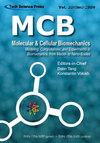Comparison of Aortic Flow Patterns in Patients with and without Aortic Valve Disease: Hemodynamic Simulation Based on PC-MRI and CTA Data
Q4 Biochemistry, Genetics and Molecular Biology
引用次数: 1
Abstract
Recent studies have revealed that aortic valve diseases are associated with the increased incidence of the aortopathy development. However, the influence of aortic valve diseases on aortic hemodynamics remains unclear. The purpose of this study was therefore to investigate the hemodynamic differenecs in patients with and without aortic valve disease through patient-specific simulations performed on two aorta models (BAV with severe stenosis vs. normal tricuspid aortic valve (TAV)). Realistic geometries and boundary conditions were obtained from computed tomography angiography (CTA) and phase-contrast magnetic resonance imaging (PC-MRI) measurements, respectively. In addition, 4D-MRI were performed to validate the the numerical methods used to simulate transient flow characteristics. Obtained results shown that the 3D streamlines in the patient with normal TAV were relatively symmetric and evenly distributed. For the patient with BAV, concentrated and high-speed inflow jets were found to impinge on the ascending aorta accompanied by strong vortices. These results indicate that the aortic valve phenotype plays a crucial role in featuring the disturbed flows primarily in ascending aorta, which may relate to the development of aortic diseases.有和无主动脉瓣疾病患者主动脉血流模式的比较:基于PC-MRI和CTA数据的血流动力学模拟
近年来的研究表明,主动脉瓣病变与主动脉病变发展的发病率增加有关。然而,主动脉瓣病变对主动脉血流动力学的影响尚不清楚。因此,本研究的目的是通过对两种主动脉模型(严重狭窄的BAV与正常的三尖瓣主动脉瓣(TAV))进行患者特异性模拟,研究有和没有主动脉瓣疾病的患者的血流动力学差异。通过计算机断层血管造影(CTA)和相衬磁共振成像(PC-MRI)测量分别获得了真实的几何形状和边界条件。此外,还进行了4D-MRI验证了用于模拟瞬态流动特性的数值方法。结果显示,TAV正常患者的三维流线相对对称,分布均匀。对于BAV患者,发现集中高速流入射流冲击升主动脉并伴有强涡旋。这些结果表明,主动脉瓣表型在主要表现升主动脉血流紊乱中起着至关重要的作用,这可能与主动脉疾病的发生有关。
本文章由计算机程序翻译,如有差异,请以英文原文为准。
求助全文
约1分钟内获得全文
求助全文
来源期刊

Molecular & Cellular Biomechanics
CELL BIOLOGYENGINEERING, BIOMEDICAL&-ENGINEERING, BIOMEDICAL
CiteScore
1.70
自引率
0.00%
发文量
21
期刊介绍:
The field of biomechanics concerns with motion, deformation, and forces in biological systems. With the explosive progress in molecular biology, genomic engineering, bioimaging, and nanotechnology, there will be an ever-increasing generation of knowledge and information concerning the mechanobiology of genes, proteins, cells, tissues, and organs. Such information will bring new diagnostic tools, new therapeutic approaches, and new knowledge on ourselves and our interactions with our environment. It becomes apparent that biomechanics focusing on molecules, cells as well as tissues and organs is an important aspect of modern biomedical sciences. The aims of this journal are to facilitate the studies of the mechanics of biomolecules (including proteins, genes, cytoskeletons, etc.), cells (and their interactions with extracellular matrix), tissues and organs, the development of relevant advanced mathematical methods, and the discovery of biological secrets. As science concerns only with relative truth, we seek ideas that are state-of-the-art, which may be controversial, but stimulate and promote new ideas, new techniques, and new applications.
 求助内容:
求助内容: 应助结果提醒方式:
应助结果提醒方式:


